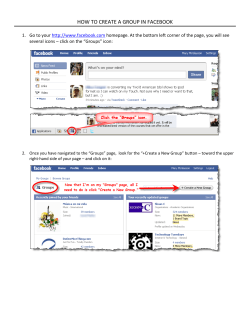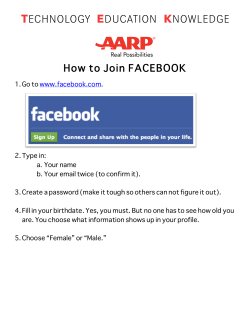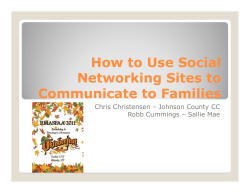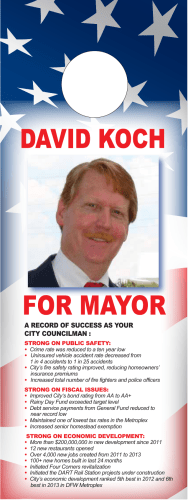
How To Configure a Google Alert
How To Configure a Google Alert 1. Go to http://www.google.com/alerts 2. In the “Search Terms” field, type in the name of the term you want to monitor. a. Use quotes around your term if you are searching for that exact phrase. For example, Pebble Beach will return anything with the words pebble and beach in it (“In the morning, I went running on the beach and got a pebble in my shoe.”), while “Pebble Beach” will return only articles and documents with that exact phrase. b. Use a hyphen immediately before a term in order to exclude pages that use the term. For example, the term Carmel will return many, many (many!) pages of people discussing Starbucks’ “carmel” macchiatos. Type Carmel –macchiato to exclude these pages. (Carmel, Indiana appears often in search results, so if you are monitoring for posts about Carmel in California, Carmel –macchiato –indiana is strongly recommended.) 3. In the “Type” field, select “Comprehensive.” This will provide news stories, blog posts, videos, and other relevant items in a digest format. 4. Select how often you would like your Google Alert delivered. a. “As It Happens” means you will get an email whenever something new is posted (and you may get many messages a day). b. “Once a day” means you will be sent a message once a day, compiling the results of the past 24 hours. This is usually sufficient. c. “Once a week” means you will be sent a message once a week, compiling the results of the past seven days. 5. In the “Email length” field, select the maximum number of results you wish to see per day – 20 or 50. 6. Under “Deliver To,” you can either type in an email address or select “Feed.” a. Type in the email address you would like the alerts to be delivered to. Google does not spam. Nicole Gustas ([email protected]) Monterey County Convention and Visitors Bureau http://www.SeeMonterey.com b. If you select feed, new items will be placed in your RSS reader on an “As It Happens” basis. (RSS readers are expained on the next page.) Nicole Gustas ([email protected]) Monterey County Convention and Visitors Bureau http://www.SeeMonterey.com RSS Feeds: What They Are and How To Use Them RSS stands for “Really Simple Syndication.” It allows a user to read a compilation of content from frequently updated online works (community discussions, blogs, Twitter searches) in one central online location, in real time. The symbol for an RSS feed is a bright orange square with a circle and two curved lines: This symbol means that an RSS feed is available for the web page in question. If you click on it, you can add it to your RSS reader, allowing you to read it at your leisure, rather than having to go to the specific website. What’s an RSS reader? An RSS reader is a piece of software, either on the web or on your desktop, that compiles all your feeds in one place. The most popular and convenient of these is Google Reader (www.google.com/reader). Other popular readers are Pageflakes (www.Pageflakes.com) and Bloglines (www.bloglines.com). Setting Up Google Reader 1. Go to the Google Reader website: http://www.google.com/reader 2. If you have a Google account, sign in now. If you do not have a Google account, click on the blue “Create an account” button. Setting up a Google account is quick, easy and free. Once you are done, return to http://www.google.com/reader and log in. Now, as long as you are logged in to Google, you will be able to automatically add a subscription to Google Reader. Nicole Gustas ([email protected]) Monterey County Convention and Visitors Bureau http://www.SeeMonterey.com Adding a Blog to Google Reader 1. Go to the blog site. 2. Click on the RSS icon. 3. You may be presented with a page that looks like this: If you see this window, click on the Google button. You will then see a page offering to add the feed to your Google Reader: Click on “Add to Google Reader.” You will now see the blog in your Google Reader page. Nicole Gustas ([email protected]) Monterey County Convention and Visitors Bureau http://www.SeeMonterey.com Subscribing To a Twitter Search in Google Reader 1. Go to http://search.twitter.com. 2. Type in your search term. 3. Hit the return button on your keyboard, or click the Search button on the screen. 4. You will see all the Tweets people have made about your search term. a. You can refine your search term by using quotes and the “-“ symbol as discussed in the “How to Configure a Google Alert” section. b. You can limit the Tweets shown to English-language only by selecting English under “Show tweets written in.” 5. In the upper right-hand corner of the page, you will see the orange RSS logo followed by the link “Feed for this query.” Click on the link. 6. Click on the “Add to Google Reader” button. The Twitter feed will now appear in your RSS reader in real(ish) time (there is frequently a lag of 30 minutes or so). Once you have subscribed to a number of feeds, you can place them in folders in order to better organize them. Nicole Gustas ([email protected]) Monterey County Convention and Visitors Bureau http://www.SeeMonterey.com Facebook Accounts It’s free to sign up for Facebook. Facebook only allows one profile per email address. Facebook does not allow page creation without a Facebook account. There are two kinds of Facebook accounts. Both accounts allow you to create Facebook Business Pages. Choose wisely, because you cannot convert from one type of Facebook account to the other. Personal Accounts The standard Facebook account is a Personal Account. This is a profile that carries as much or as little information about you as you choose. You can also hide your information from search, so no one will be able to see you. A Facebook Personal Account allows you to maintain your Business Page and place ads. You can also look at user profiles (if they give you permission), look at content on other Pages, and otherwise use Facebook as much (or as little) as you want. Personal Accounts provide a user with the most flexibility, and are recommended. Facebook personal accounts are created before you create your Business Page. Business Accounts Facebook Business Accounts only allow you to maintain a Business Page and place ads for that page. You cannot look at the profiles of your fans, look at other Business Pages, or do any of the many things Facebook allows a Personal Account to do. These limitations can create obstacles to using a page for your business. If you prefer to create a Facebook Business Account, you will create it as you are creating your page. Nicole Gustas ([email protected]) Monterey County Convention and Visitors Bureau http://www.SeeMonterey.com How to Sign Up for a Facebook Personal Account 1. Go to http://www.facebook.com 2. You should see a screen that looks like this: Figure 1. Facebook signup screen If you see a screen that looks more like this: Figure 2. Facebook user landing page it means that someone is already logged in using your computer. Click on the “Logout” button in the upper right hand corner to get back to the screen showed in Figure 1. Nicole Gustas ([email protected]) Monterey County Convention and Visitors Bureau http://www.SeeMonterey.com 3. In the “Sign Up” area, enter your first name, last name, email, password, sex, and birth date. 4. Click the green “Sign Up” button. 5. Facebook will then present you with a security check that looks something like this: Figure 3. Facebook security check This is to prevent computers from auto-creating account. Computers can’t read the words “sunset” and “the” in the white box, but humans usually can. The words that appear for you will be different than the ones in the above example. Type in the two words and click “Sign Up.” Nicole Gustas ([email protected]) Monterey County Convention and Visitors Bureau http://www.SeeMonterey.com 6. Facebook will now give you the opportunity to find friends that have already created Facebook accounts. You will see the following window: Figure 4. Find friends on Facebook When you enter your email password, you are giving Facebook a one-time opportunity to look at your email address book. It will cross-reference those email addresses with the email addresses of users that are already on Facebook. Facebook will then show you a list of people in your address book that are already on Facebook, and you can choose whether or not to make them your “Facebook friend.” If you do not want to allow Facebook to see your address book, click “Skip this step” in the lower right-hand corner. You will note that Facebook makes the “Skip this step” item a little hard to find. That’s because it’s in their best interest for you to link to as many people as possible when you start. The more people you are connected to, the more likely you are to use the site. 7. Next, Facebook will ask you for demographic information such as your high school, your college, and the company you work for. Facebook will then use this information to present you with more potential friends – for example, users who graduated from your high school the same year as you did. Nicole Gustas ([email protected]) Monterey County Convention and Visitors Bureau http://www.SeeMonterey.com Figure 5. Profile Info screen If you prefer not to give Facebook this information (or if you really didn’t like anyone you went to high school with), click on the extremely small “Skip” word to the left of the large “Save and Continue” button. 8. Facebook will now ask for a photo. If you have a photo of yourself on your computer that you’d like to use, click on “Upload a Photo,” and then click on “Choose File.” This will bring up a window that will allow you to browse through your computer’s files to find a picture of yourself. If you choose not to put up a photo of yourself, click the small “Skip” to the left of the large “Save and Continue” button. 9. If, in the previous steps, you have selected any friends, you will now see a page that shows your friends’ status updates. If you have not, Facebook will provide links to find people you know, and to edit your profile to help your friends find you. Nicole Gustas ([email protected]) Monterey County Convention and Visitors Bureau http://www.SeeMonterey.com Become the Invisible Man (or Woman): Facebook Security Settings Facebook has robust security settings which which you can allow the world to see as much – or as little – of you as you prefer. With Facebook’s security settings, you can make yourself almost entirely invisible. Here’s how. 1. Click on the Account button on the top bar of Facebook. 2. Figure 6: Facebook navigation bar, with Account button circled. 3. On the drop-down menu that appears, click on the item “Privacy Settings.” Figure 7: Facebook account management menu, with “Privacy Settings” circled. Nicole Gustas ([email protected]) Monterey County Convention and Visitors Bureau http://www.SeeMonterey.com 4. You now have access to the Privacy Control Panel. Figure 8: The Facebook privacy control panel. 5. In the Privacy control panel, click “Search.” 6. This panel allows you to control to whom you appear in Search. a. Facebook Search Results allows you to control who can find you in Search. i. Everyone means that any Facebook user can find you. ii. Friends of Friends means that both your friends and their friends will see you if they type your name into Search, but no one else will. iii. Only Friends means that only people who you designate as friends will be able to find you in Search. b. Public Search Results: if the box is checked, your Facebook page will appear in Google, Yahoo!, Bing and other search engines. Facebook has very good search rank, so it will probably appear on the first page of search results. 7. When you are done, click “Save Changes.” For more specific control of what various groups of users can and cannot see on your profile, select “Profile Information” and “Contact Information” in the Privacy control panel. To prevent specific people from contacting or finding you, click on “Block List.” Nicole Gustas ([email protected]) Monterey County Convention and Visitors Bureau http://www.SeeMonterey.com Creating a Business Page in Facebook Businesses have a separate type of page than people. While a Personal Account can only have 5,000 friends, a Business Page can have an unlimited number of fans. In general, Facebook’s page creation setup is very intuitive. However, there are a couple of sticking points that can cause a large hassle down the line. These steps are highlighted below. 1. Search the word “Facebook page” in Google. (There are ways to find the interface in Facebook, but this is much easier.) One of the first results should say “Create a Page | Facebook.” Click on this result. Figure 8: The Google search results for the term “Facebook page.” The most useful result is circled in red. 2. The next page allows you to choose your page category. Once you select your page category, you cannot change it, so consider carefully before you do it! Nicole Gustas ([email protected]) Monterey County Convention and Visitors Bureau http://www.SeeMonterey.com Figure 9: Creating a new Facebook page. a. The larger categories “Local,” “Brand, Product or Organization” and “Artist, Band or Public Figure” each have slightly different templates. i. Sub-categories under “Local” will allow you to provide your Address, Phone, and Hours in the information section. ii. Sub-categories under “Brand, Product or Organization” do not have an area for Address, Phone or Hours – they are geared toward an overview of a nationwide business. iii. In general, sub-categories under the “Local” category are probably preferable for CVB members. b. “Hotel/Lodging” appears under both “Local” and “Brand, Product or Organization.” c. “Restaurant” appears only under “Local.” Restaurants could also be categorized under “Food and Beverage” in “Brand, Product or Organization” d. Since users generally search for a business or brand by name, the category is most important in the way it affects the information you can put on a page. 3. The name of your page should be the name of your business. 4. Beneath “Name of Page,” check the box labeled “Do not make Page publicly visible at this time.” This will allow you to perfect your Page before you reveal it to the world! Nicole Gustas ([email protected]) Monterey County Convention and Visitors Bureau http://www.SeeMonterey.com 5. Once you are done, click the “Create Page” button. Your initial page will look something like this: Figure 10: A newly-created Facebook page Enhance your page 6. To make your page more inviting, add information to it. Start by clicking on the words “Edit Information” that are below and to the right of your business name. 7. Under “Basic Info,” add basic information on your business, such as your hours, your address and your phone number. Then click “Save Changes.” 8. The “Detailed Info” area will open up. In this area, you can add your website address as well as parking information and information on public transit to your business (if desired). Then click “Save Changes.” 9. Once you are done, click “Done Editing.” You’ll now see your information as a user would see it. To change it, click the “Edit Information” button again. 10. To add a photo, hover your mouse cursor over the large gray question mark on the left hand side of the page. The words “Change Picture” will appear. Click on them to upload a photo from your computer. Nicole Gustas ([email protected]) Monterey County Convention and Visitors Bureau http://www.SeeMonterey.com Facebook Page Settings Just like your personal Facebook account, you can limit what people can do on your Facebook business page. 1. Just below your Facebook picture, click “Edit Page.” 2. Under “Settings,” click “Edit.” a. Country restrictions allows you to restrict viewing of your page to people in certain countries. b. Age restrictions allows you to limit the ability of people under a certain age to view your page. If you are a winery, you will want to select “Alcohol-Related,” which will set the minimum age based on the drinking age in the country of origin of the user. c. Published status allows you to select whether or not the page is viewable to the world. You may not be ready for this yet – if not, just remember where it is for later. 3. Once you are done, click “Save Changes.” 4. Wall settings allow you to control who can post to your page. The “wall” is what users usually first see when they come to your page. a. Only posts by page means that users will by default only see the things you post. b. Posts by page and fans means that users will see both your posts and your fans posts intermingled, sorted by date. c. Default landing tab for everyone else allows you to choose what the first tab is that people will see when they come to your Page. d. Fan Permissions allows you to choose whether or not fans can post to your wall, and what they can post. The temptation is to prevent fans from posting to your page, because you cannot control their message. However, fans expect to be allowed to post things to your page. If you don’t let them, they will feel that you don’t have any interest in them or what they have to say. If you don’t want to allow fans to post anything to your page, you may want to consider whether a Facebook Page is appropriate for your business. Nicole Gustas ([email protected]) Monterey County Convention and Visitors Bureau http://www.SeeMonterey.com
© Copyright 2025









